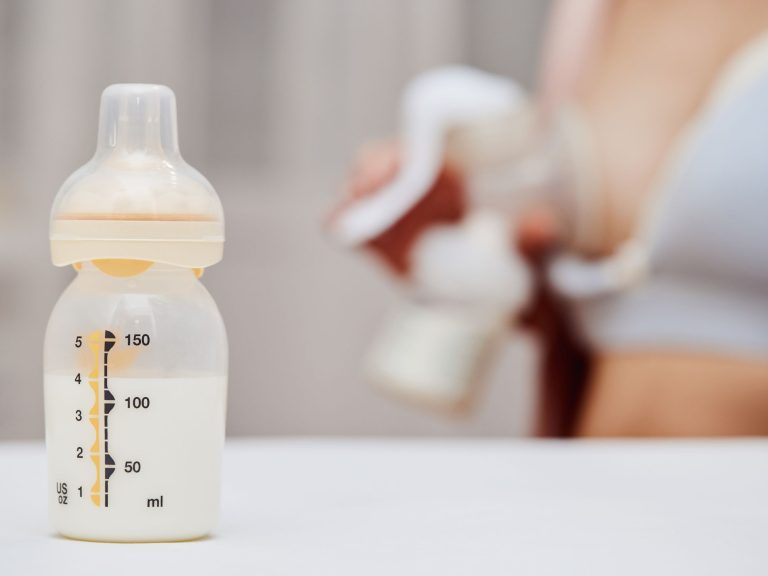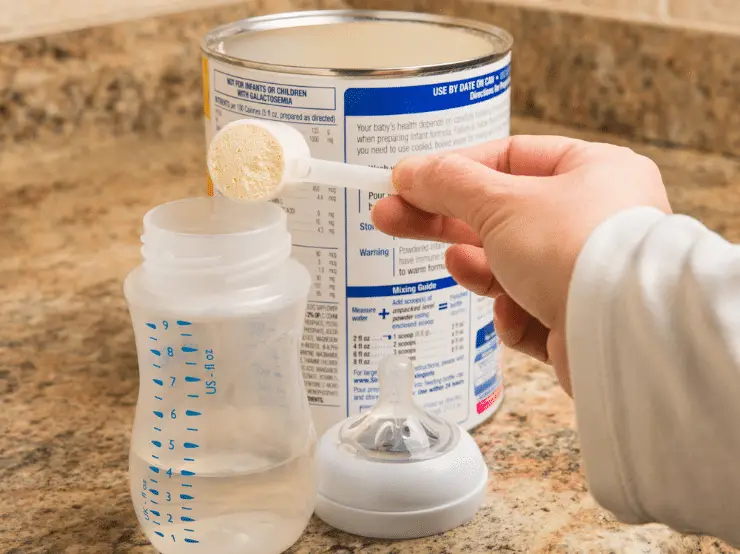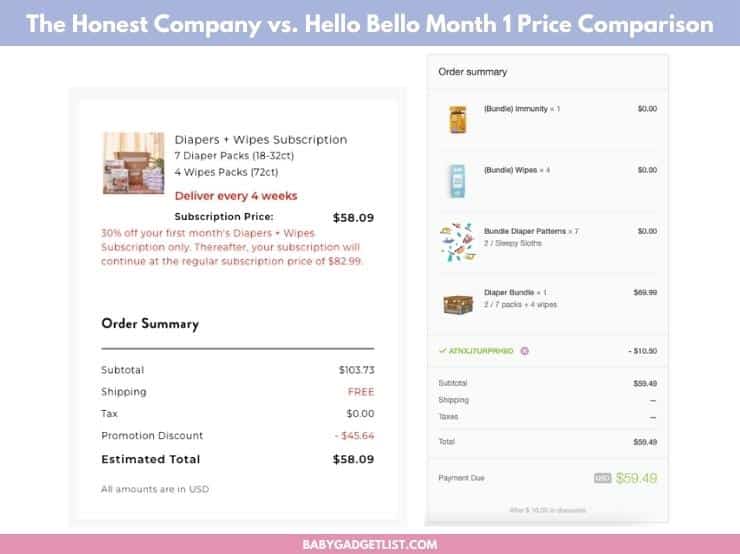Choosing The Right Baby Formula: A Comprehensive Guide
Are you a new parent looking for the right baby formula? With so many options available, it can be overwhelming to choose the best one for your little one. But don’t worry, this comprehensive guide is here to help you make an informed decision.
First, it’s important to understand the different types of baby formula available. From cow’s milk-based formulas to hypoallergenic options, each type has its own unique benefits and considerations.
Note: This post may contain affiliate links, which means if you buy from my link I might make a small commission. This does not affect the price you pay. See the full affiliate disclosure here.
By decoding the label and considering your baby’s needs, you’ll be able to narrow down your choices and find the perfect formula.
Plus, with tips on preparing and storing formula safely, you’ll have all the information you need to confidently feed your little one.
So let’s get started on choosing the right baby formula for your precious bundle of joy!
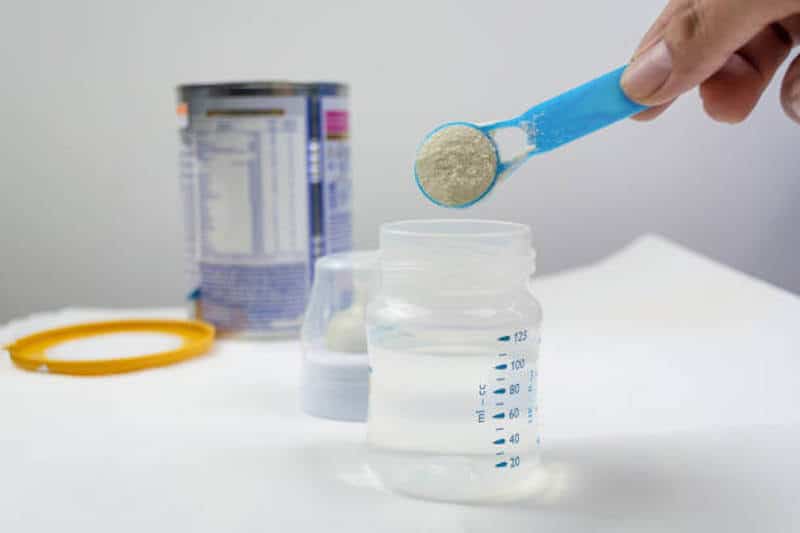
Understanding the Different Types of Baby Formula
Now that you’re familiar with the different types of baby formula, it’s time to dive deeper into their unique features and benefits.
When choosing the right baby formula for your little one, it’s important to understand how each type compares to one another. For instance, while cow’s milk-based formula is the most commonly used type, some babies may require a lactose-free or soy-based option due to allergies or sensitivities.
It’s also essential to consider brand recommendations when selecting a baby formula. There are countless options available on the market today, but not all brands are created equal. Look for reputable companies that have been endorsed by healthcare professionals and have positive reviews from other parents.
Additionally, keep in mind that more expensive doesn’t necessarily mean better – focus on finding a formula that works best for your baby’s needs rather than solely relying on price point.
Decoding the Label
When it comes to choosing the right baby formula, decoding the label can be a daunting task. However, by learning to read and understand the key ingredients listed on the label, you can make informed decisions about what to feed your little one.
Look for high-quality ingredients such as whey protein and lactose while avoiding artificial additives like corn syrup solids or soy protein isolate. Additionally, pay close attention to nutritional information such as calorie count and vitamin content to ensure that your baby is getting everything they need for healthy growth and development.
Ingredients to Look For
Take a closer look at the ingredient list to ensure your little one’s formula provides the necessary nutrients. Here are three key ingredients to consider:
- Carbohydrates – Look for lactose as the primary carbohydrate source, not corn syrup or other sweeteners. Lactose is similar to breast milk and promotes healthy digestion.
- Probiotics – These beneficial bacteria support your baby’s immune and digestive health. Some formulas include probiotics, especially helpful if your baby has had digestive issues.
- DHA & ARA – These fatty acids are essential for infant brain development. Ensure they come from a reputable source, not genetically modified organisms (GMOs).
By paying attention to these ingredients, you can provide the nutrition your baby needs, avoiding allergens and opting for organic options. Remember to consult your pediatrician before changing your baby’s diet or feeding routine.
Ingredients to Avoid
It’s important to be aware of certain ingredients that can be harmful to your baby and avoid them when selecting their formula.
One of the most common ingredients to avoid is high-fructose corn syrup, which can lead to obesity and diabetes in children.
Additionally, soy protein isolate should also be avoided as it has been linked to potential health risks such as thyroid dysfunction and hormonal imbalances.
Another ingredient to watch out for is carrageenan, a thickening agent that has been shown to cause inflammation in the digestive system.
Artificial sweeteners like sucralose and aspartame should also be avoided as they have been linked to negative effects on brain development in infants.
By avoiding these harmful ingredients, you can ensure that your baby receives a formula that promotes healthy growth and development without any potential health risks.
Always read the label carefully before making a purchase and consult with your pediatrician if you have any concerns or questions about the ingredients in your baby’s formula.
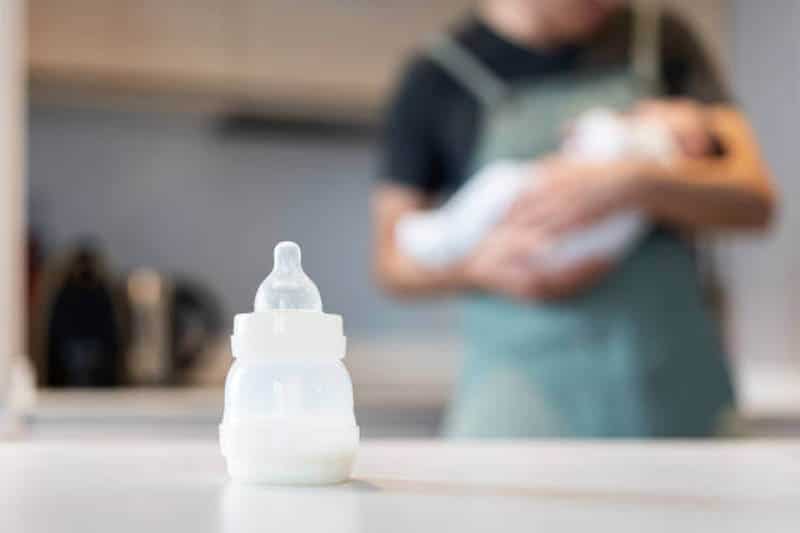
Nutritional Information
Get ready to nourish your little one with all the essential nutrients they need by checking out the nutritional information section of their formula. When it comes to baby formula, not all brands are created equal.
It’s important to compare and contrast the nutritional value of different formulas before making a decision. Recommended brands typically provide detailed information about the nutrients found in their formula, including protein, fat, carbohydrates, vitamins, and minerals.
It’s important to ensure that your baby is getting enough of each nutrient for proper growth and development. Comparing the nutritional values between different brands can help you make an informed decision on which formula is best for your little one.
Remember that every baby is unique, so what works for one may not work for another. Consulting with a pediatrician can also be helpful in determining which brand and type of formula will be most beneficial for your child’s specific needs.
Considering Your Baby’s Needs
Understanding your little one’s unique requirements is vital when deciding on the ideal nourishment for them. While breastfeeding is typically recommended as the best source of nutrition for babies, sometimes it may not be feasible due to various reasons.
In such cases, you need to consider your baby’s needs before choosing a formula that suits them best. If your baby has any allergy concerns, it’s essential to opt for hypoallergenic or specialty formulas.
Some babies may also have acid reflux or digestive issues, in which case you can choose an anti-reflux formula or one with added probiotics that promote gut health.
Additionally, premature babies may require special formulas that cater to their specific nutritional needs. Always consult with your pediatrician before making any changes to your baby’s diet and ensure that they’re getting all the necessary nutrients for healthy growth and development.
Preparing and Storing Baby Formula
When it comes to preparing and storing baby formula, there are a few key points that you need to keep in mind.
First and foremost, it’s important to sterilize your bottles and nipples before each use to ensure that your baby stays healthy.
You’ll also want to pay close attention to measuring and mixing the formula correctly, as this can impact your baby’s digestion.
Finally, proper storage and handling is crucial for maintaining the quality of your baby’s formula over time.
By following these guidelines, you can be sure that your little one is getting the best possible nutrition.
Sterilizing Bottles and Nipples
Proper sterilization of bottles and nipples is crucial for maintaining your baby’s health and preventing the spread of harmful bacteria. From birth until about 3 months old, it’s recommended to sterilize all feeding equipment daily.
After that, you can reduce the frequency to once a week or as needed. There are several ways to sterilize bottles and nipples, including boiling them in water on the stove, using an electric steam sterilizer, or soaking them in a solution of hot water and bleach.
To boil bottles and nipples, first wash them thoroughly with soap and warm water. Then place them in a pot filled with enough water to completely cover them. Bring the water to a rolling boil for at least 5 minutes before removing everything from the heat source.
Allow the items to cool down before removing them from the pot with clean tongs or hands washed in soap and warm water. Alternatively, an electric steam sterilizer uses high-temperature steam to kill germs without using chemicals or excessive heat. Follow manufacturer instructions carefully when using any type of sterilizing equipment for best results.
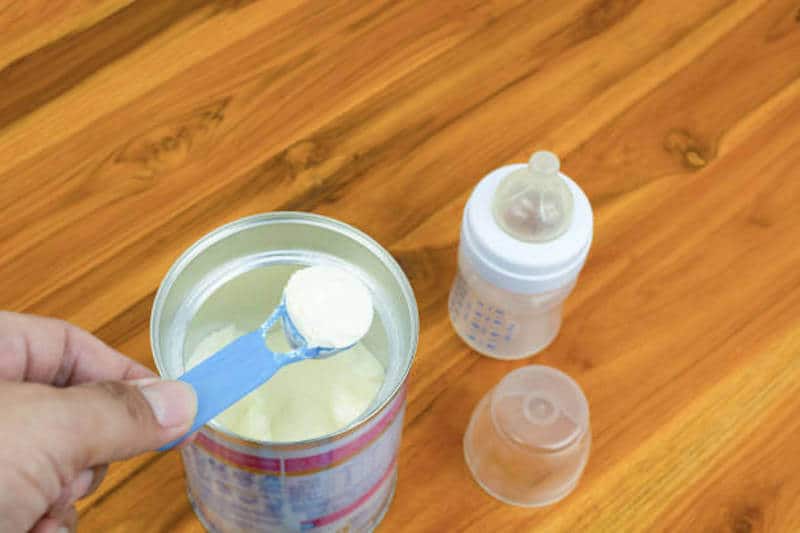
Measuring and Mixing Formula
In this section, we’ll learn about measuring and mixing formula to make sure your baby gets the right amount of nutrition they need. Measuring accuracy is crucial when preparing your baby’s formula, so always use a measuring spoon or cup specifically designed for formula measurements.
Regular kitchen utensils may not provide the exact amount needed. Also, make sure to level off each scoop to ensure consistency in measurement.
When mixing the formula, follow the instructions found on the label carefully. The most common ratio is one scoop of powder for every two ounces of water, but be sure to double-check with your pediatrician or consult with the manufacturer if necessary. Shake or stir thoroughly until all lumps have dissolved before feeding it to your little one. Improperly mixed formula can lead to digestive issues such as constipation or diarrhea.
Bottle preparation techniques are also important in ensuring that your baby’s formula is safe for consumption. Always sterilize bottles and nipples before using them by boiling them in a pot of water for at least five minutes or running them through a dishwasher cycle.
Let them cool down completely before assembling and adding in the prepared formula. It’s best to warm up refrigerated bottles by placing them in a bowl of hot water instead of microwaving them directly, as uneven heating can cause hot spots that may burn your baby’s mouth.
By being meticulous with measurements and bottle preparation techniques, you’ll be providing your baby with optimal nutrition while keeping them healthy and happy!
Proper Storage and Handling
Make sure you handle and store your baby’s formula correctly to prevent contamination and ensure that it remains safe for consumption.
One of the most important things to remember is to always wash your hands thoroughly before preparing or handling the formula. This will help reduce the risk of introducing harmful bacteria into the mixture.
Additionally, make sure to use clean utensils and bottles when mixing the formula.
When it comes to storing your baby’s formula, it is important to follow the recommended guidelines on the packaging. Most formulas have a shelf life of about 2 years if unopened, but once opened they should be used within a month.
Store opened cans or containers in a cool, dry place away from direct sunlight or heat sources. After mixing the formula, any unused portions should be discarded after 1 hour at room temperature or after 24 hours if refrigerated.
By following these simple steps for proper storage and handling of your baby’s formula, you can help ensure that it remains safe for consumption and prevent any potential contamination issues.
Making the Final Decision
When it comes to making the final decision on which baby formula to use, there are several key points to consider.
Firstly, it’s important to consult with your pediatrician who can provide tailored recommendations based on your baby’s individual needs.
Additionally, don’t be afraid to try different formulas and switch between them if necessary.
Lastly, carefully monitor your baby’s health and development as they transition onto a new formula.
By taking these steps, you can ensure that you’re giving your little one the best possible start in life.

Consulting with a Pediatrician
Talking to a pediatrician is crucial when deciding which type of nourishment to provide for your little one. Pediatrician recommendations are based on scientific evidence and years of experience, making them the most reliable source of information.
Before making any decisions, it’s important to consult with a pediatrician who can guide you towards choosing the right baby formula. The benefits of consulting with a pediatrician are numerous.
Firstly, they can help you understand your baby’s nutritional needs and recommend the best type of formula that meets those needs. Secondly, they can also advise you on how much and how often to feed your baby depending on their age and growth rate.
Thirdly, they can alert you if there are any potential health concerns related to certain types of formulas or ingredients that may not be suitable for your baby’s unique situation. With their expertise and guidance, you can feel confident in providing your little one with the best possible nourishment for optimal growth and development.
Trying Different Formulas
Now it’s time to experiment with various types of formula to see which one your baby prefers and thrives on, creating a journey of discovery as you watch them grow. Trying different formulas is an essential step in finding the right option for your little one.
Remember, babies are unique individuals, and what works for one may not work for another. When trying different formulas, start by introducing new ones gradually. Mix a small amount of the new formula with the old one over a few days and observe how your baby reacts.
If they experience any discomfort or allergies, stop using that formula immediately and consult with your pediatrician. Finding alternatives to cow’s milk-based formulas may be necessary if your baby shows signs of lactose intolerance or a milk allergy. Soy-based formulas or hypoallergenic options are available in such cases.
Keep in mind that some babies may need more specialized formulas due to medical conditions like reflux or prematurity. Don’t hesitate to reach out to your pediatrician for guidance when navigating these options.
Switching Between Formulas
As you continue to nourish your little one, it’s important to consider the benefits and potential challenges of switching between different formulas, ultimately finding the perfect fit for your growing baby.
While sometimes necessary due to allergies or digestive issues, switching between formulas can be a challenge for both parents and babies. One of the biggest challenges in switching formulas is ensuring a smooth transition.
Abruptly changing your baby’s formula can lead to discomfort and even diarrhea. To avoid this, experts recommend gradually introducing the new formula by mixing it with the old one in increasing amounts over a period of several days. This allows your baby’s digestive system time to adjust and reduces the likelihood of any adverse reactions.
Additionally, it’s important to closely monitor your baby during this transition period for any signs of discomfort or allergic reactions. By following these transition tips, you can help ensure a successful switch to a new formula that meets all of your little one’s nutritional needs.
Monitoring Your Baby’s Health and Development
To make sure your little one is growing strong and healthy, it’s important to keep a close eye on their health and development by monitoring their milestones and seeking advice from healthcare professionals when needed.
Tracking milestones, such as rolling over, sitting up, crawling, walking, talking, and interacting with others can give you an idea of where your baby is at in terms of physical, cognitive, social-emotional development.
While every child develops at their own pace and there may be variations in the timing of these milestones among individuals or cultures, if you notice any significant delays or regressions in your baby’s progress, it’s recommended to talk to your pediatrician or a developmental specialist.
In addition to milestone tracking, you can also monitor your baby’s health and well-being by observing their eating habits (e.g., appetite changes), sleep patterns (e.g., duration and quality), bowel movements (e.g., frequency, consistency), skin appearance (e.g., rashes), behavior (e.g., fussiness), growth charts (e.g., weight gain).
By keeping track of these factors regularly and reporting any concerns or questions to your healthcare provider promptly, you can help prevent or address potential issues that may affect your baby’s nutrition absorption or immune system.
Seeking medical advice doesn’t mean that something is necessarily wrong with your baby but rather that you are being proactive about their care as a responsible parent/caregiver who wants the best for them.
Conclusion
You made it to the end of this comprehensive guide on choosing the right baby formula! By now, you should have a good understanding of the different types of baby formula and how to decode their labels.
You also know how to consider your baby’s needs when selecting a formula, as well as how to prepare and store it properly.
Remember, there’s no one-size-fits-all when it comes to feeding your baby. Every child is unique, so it’s essential to pay attention to their individual needs and preferences. Be sure to consult with your pediatrician if you have any questions or concerns about which type of formula is best for your little one.
In conclusion, choosing the right baby formula can be overwhelming, but with the information provided in this guide, you’re well-equipped to make an informed decision. With careful consideration and preparation, you can provide your little one with proper nutrition that’ll help them grow and thrive. Best of luck on your parenting journey!

